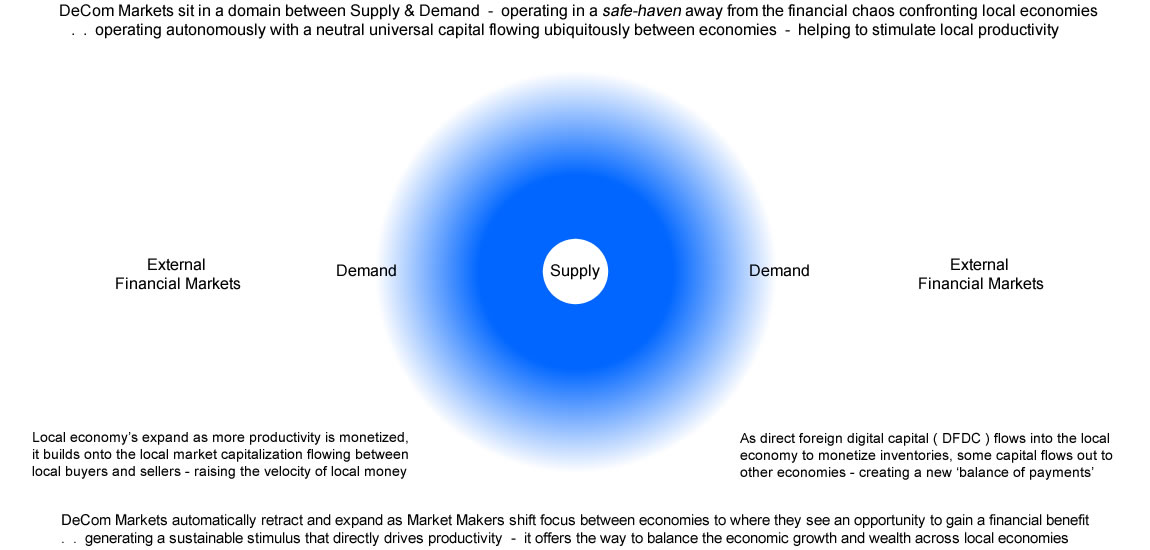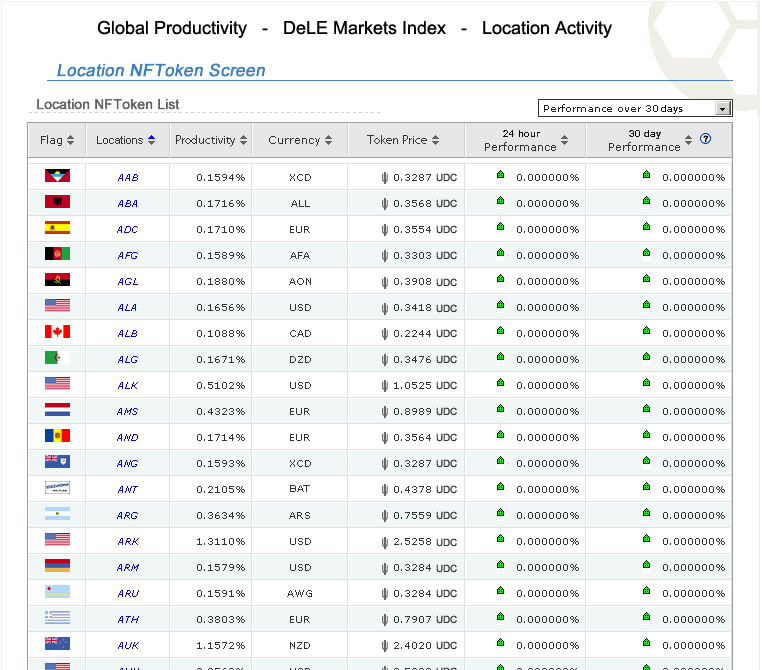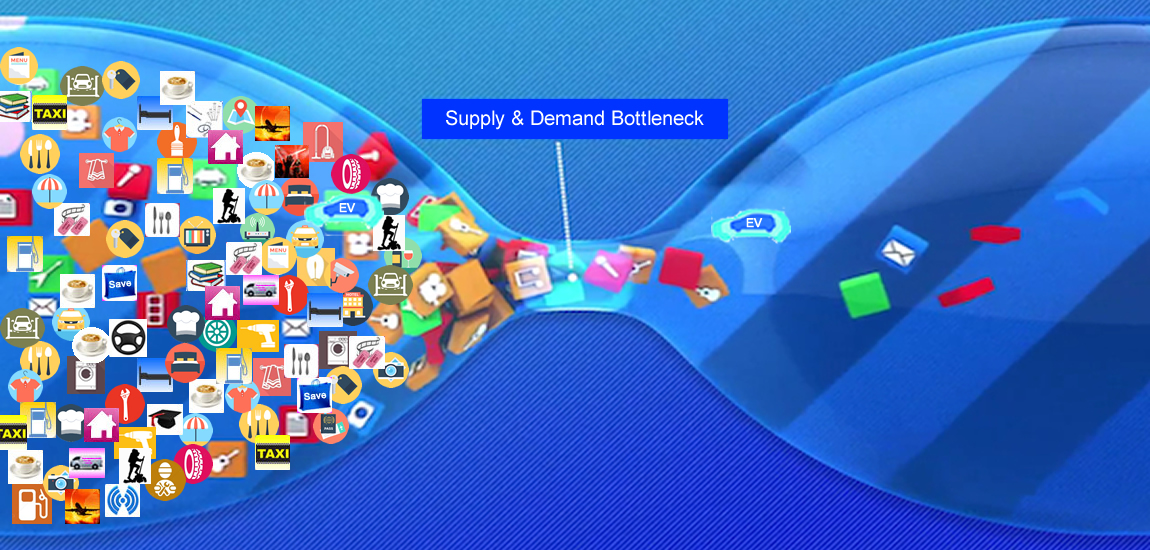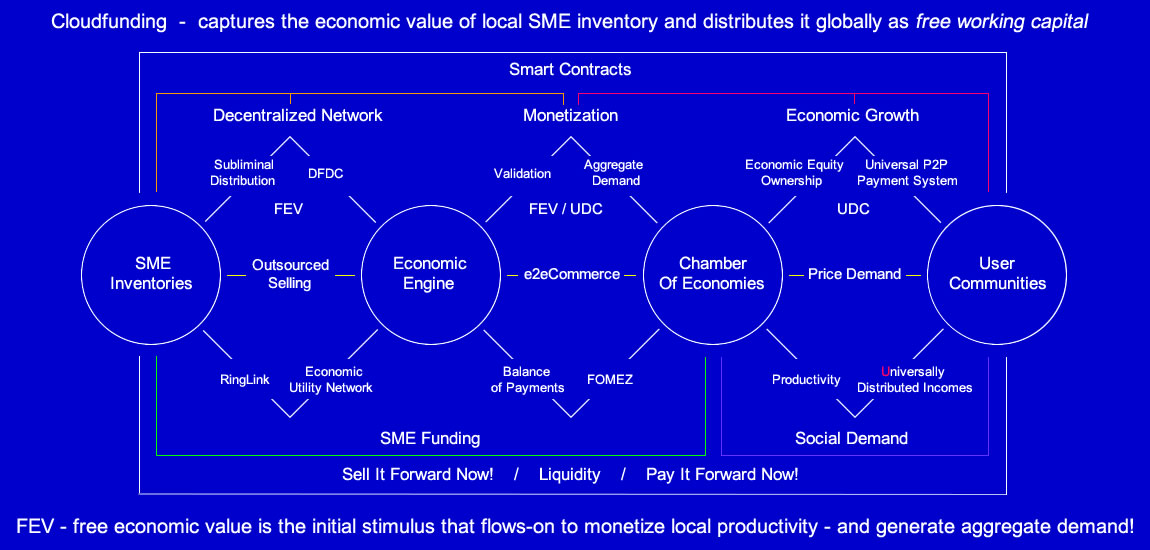


DeCom Markets FOMEZ GPEUN Queen Bee DOMIndex Economic Engine FEV Smart Contracts UDC DFDC UDI PriceDemand Cloudfunding Main St

Using the economic value of local economies instead of credit or money offers a unique approach to driving economies towards greater volumes of productivity without creating debt. Decentralized Local Economic Markets fit between the seller's supply side and the buyer's demand side, without requiring an external value or central controller to dictate borrowing and usage of products (credit/money). This can hinder productivity as borrowers are subject to forces outside their control, such as economic downturns and changes in interest rates.
Technology can bypass the traditional management tools that central authorities still attempt to use to control global interactions using credit and debt. Decentralized mechanisms and real-time data can respond more effectively in the digital economy than the old economy's thinking that small interest rate adjustments can affect changes. While these adjustments may influence financial markets, they have little to no impact on productivity in the real grassroots economy.
Changing the mechanics of capital flows to flow between the supply side and the demand side with incentives to stimulate productive activity within an infinite loop that can seamlessly move across borders and industries makes SMEs and all size Main Street businesses "the new local banks." This approach provides a more responsive and efficient way to drive economic growth and productivity without relying on traditional credit and debt systems.
Global users directly fund local SMEs when they 'collect' local economy tokens
Users hold UDI portfolios, where they can collect units in various locations worldwide, directly funding industries and businesses in those local economies. This funding is free for businesses to invest back into their operations to generate supply and incentivize global users to support local economies by being proactive as OMMs. Users benefit from distributed gains from productivity in local economies within their UDI portfolios.
DeCom Markets utilize technology that tracks the economic value in productivity in local economies down to 14 decimal points as it is interacted with globally in real-time without using credit and debt as instruments of control. Instead, technology can capture the aggregate demand of global productivity and drive it back into local economies through a recycling mechanism that validates the massive stockpile of inventory. Initially distributed subliminally as free working capital, this process activates an existing resource waiting to be turned into sales, offering sellers full selling prices paid in real-time without credit terms and providing buyers with affordable prices they want to pay on a global scale.
Retractable market dynamics create a new dimension
As more market makers focus on specific locations by helping to drive productivity and collecting more units, the dynamics change with a lower share of the economic equity available. This specific dynamic adds another layer of strategy for market makers to decide whether to increase their direct involvement in generating more productivity (if there is any to monetize) or shift their focus to other economies. When some market makers liquidate the number of location units and move to other locations, they are essentially expanding one market and contracting another. As units are liquidated, they dissolve, leaving the remaining market makers with a greater share of the economic equity available, which they can continue to benefit from as they help drive productivity.
This change in dynamics alters how traditional Balance of Payments are handled with economies by financial markets and systems at the national level, bringing it down to a decentralized local level that can directly balance the flow of trade and payments in real-time.


It's a new market, and a paradigm shift in how capital flows between buyers and sellers
The economic infrastructure behind the economic markets represents a revolutionary change in empowering a resource that has been largely untapped—an unlimited resource with an economic value representing the true commercial value of local economies. This valuable resource has been ignored by the financial system due to the inability to liquidate its true value into capital. Economic markets leverage technology to capture the full retail selling price potential of local inventories for sellers and release it to consumers with the ability for buying prices to cascade down to 20% of the full selling prices without affecting the seller's full prices. This technology enables tracking of new capital flows specifically between the supply side and the demand side, from when inventory is ready to be sold to when products and services are purchased and exchanged with buyers (without holding or transferring any local currencies across borders).
This process is facilitated by an economic value governed constantly by products and services linked to a Global Price Index, which is entirely different from the financial system's approach of creating money out of thin air (like credit and bonds) to be thrown into financial markets without any consideration of tying it to real productive value.
The economic value has a unique, autonomous position in the mechanics between supply and demand, allowing it to facilitate trade between buyers and sellers without an external product like money provided by the financial system, even cryptocurrencies. This eliminates the need for third-party incumbents such as payment providers or currency exchanges, avoiding speculation, interest, fees, or spreads. This allows the entire economic value to be used as a stimulus to generate productivity in local economies through a balance of payments that provides a democratic and vibrant way to monetize inventory. This is crucial for SMEs in the real economy, as they can outsource the selling of their inventory at full selling prices in a matter of days or even hours to monetize and achieve cashflow liquidity with sales, compared to weeks or months to obtain credit or loans (if possible) that require collateral like houses.
The volume of local seller inventory value is significantly greater than the volume of credit and loans that could ever be created and approved, making this approach far more efficient and effective in driving productivity in local economies.
Decentralized Commerce Markets move to the pace of productivity in real time

It's no longer about money created from nothing but about economic value tied to productivity
Economic markets differ from financial (share) markets by having an architecture that only works with linear growth, increasing when there is productivity in a location (local economy). The growth may be zero due to no productivity, but it can never be negative, unlike share market crashes. The open market design allows market makers to seamlessly move strategies between local economies as they see opportunities to gain a bigger share of the productivity's LAT (location activity tax) that is distributed in real-time to users holding various locations. This can build out to thousands of local economies worldwide, positioning global users as economic equity owners of local economies. This gives users holding ownership a reason to ensure that productivity is continually generated by market makers.
Each global user has a universally distributed income portfolio to operate with as protection against inflation, referred to as a universal basic income. Instead of wealth and income gained from a local tax on a single country's society, it is drawn from the collective productivity across thousands of grassroots local economies worldwide, providing a more stable and sustainable income source.
Decentralized economic markets are designed to be pro-active
The financial markets are structured around the share market as the leading indicator of company efficiency and profitability, relying entirely on investors channeling money into buying shares in companies for dividends and rising share prices. The skills of company strategists, analysts, and traders have been refined since the East India Company's formation to convince people to invest money so companies can expand and increase productivity. This formula and ideology have evolved over time, tilting the distribution balance in favor of those steering and sharing the profits.
Economic markets have always existed but have never been formally modeled until now, representing the productivity of local economies down to towns, cities, regions, and countries. While every economy varies in size, the new economic markets platform treats them equally using an open market democratic formula, allowing local markets to expand the number of location units available as market makers see opportunities to drive productivity in specific locations through industries and businesses. Market makers use direct strategies to benefit from a greater share of the local economic equity they help generate in grassroots supply chains within real local economies.
Benefit from productivity flows into Universally Distributed Incomes
The economic markets operate in real-time, meaning that as market makers drive local productivity by monetizing the seller's inventory, they wait for local buyers to use price demand and cascading buying prices, which trigger the release of the seller's full selling prices and the LAT (location activity tax) to complete the real-time process. This process then distributes the increase in the location unit's value to holders as universally distributed income. This direct involvement of market makers, who are proactive in making individual strategies to generate productivity in economic markets in real time, differs significantly from how financial markets operate.
Local economies can avoid bottlenecks in the supply chain
With the volume of economic value sitting in inventories exceeding the volume of loans and credit that the financial system can release across local communities, there's a compelling reason to establish decentralized but independent, accountable economic infrastructure capable of handling new capital flows in real-time between the demand side and the supply side. This infrastructure can avoid bottlenecks between markets and provide a more efficient and effective means of driving productivity in local economies.


Decentralized Commerce Markets - are designed to scale productivity
The financial markets are centered around money as the primary product and value, which is lent out to borrowers who pay interest during its use. The basic goal is to build economic wealth for borrowers and provide profit to lenders. However, money created out of thin air for lending purposes comes with risks of no productive outcome or failure to repay, leading lenders to prefer speculating on asset prices and artificially controlling prices rather than generating productivity.
The decentralized local economic markets offer a unique approach, using an economic value tapped from local inventories with intrinsic value, constantly tied and governed by the volume of productivity in product and service sales across all local economies. Productivity is the main mechanism for local economies to gain economic wealth through trading products and services from the supply side to the demand side of markets. DeCom Markets disrupt the status quo by shifting productivity from the last step in the financial system's labyrinth of rentier services to the leading catalyst, directly driving economic wealth and growth into local economies through debt-free stimulus sustained by supply seeking demand in outsourced selling of inventories at full selling prices and cascading buying prices.
The economic value of inventories in local economies is a resource with intrinsic value that's trackable on a global scale and cannot be manipulated in value or increased like asset prices. It can be distributed as free working capital across real local economies worldwide, capturing the aggregate demand of global productivity and validating free working capital into a neutral universally decentralized capital, which can then be liquidated into global currencies at local businesses without interest or costs.
The Electric Vehicle industry's limited success in sales can be compared to the reinvention of the assembly line and increased productivity of the early 1900s. DeCom Markets' economic infrastructure, with outsourcing selling of inventories at full selling prices and price demand with cascading buying prices, can place the Electric Vehicle industry in the fast lane for scaling productivity in the 21st Century. The fully monetized inventories for sellers before releasing EVs to local buyers guarantee sales even before buyers have the chance to pay prices they want to pay.
Economic value is the true value of the real economy
Tapping each local economy's economic value through subliminal organic advertising before validating it as a means of exchange presents a significant difference from the financial system's creation of money to facilitate commerce. In real economies, economic value serves as the new economy's foundational value that cannot be destroyed or diluted, unlike money created for credit, which is destroyed when repaid to balance the lender's books, effectively diluting local economies' economic wealth as payments and additional interest payments are taken out of local cashflows using real money gained from real productivity (wages, etc.).
In DeCom Markets, as the economic value is validated from free working capital into the neutral universally distributed capital by recycling the global aggregate demand of productivity/actual sales, its value cannot be diluted or changed when transferred across the world without costs. It has one important attribute: from its origin, it can be tracked from peer to peer down to 14 decimal points in real-time for security.
The supply of universally distributed capital held by global users increases organically as more productivity is validated in local economies, and its value remains stable by using the aggregate value of global currencies, allowing it to maintain a neutral position as it integrates across supply and demand in local economies. The benefit of being uniquely stable against all global currencies allows asset prices to maintain stability without needing to use inflation, while local currencies fight to hold value against other currencies.

Main Street now has a sustainable cashflow model
Main Street represents the traditional center of local commerce, and Cloudfunding is ushering in a new era of selling for Main Street, powered by technology to deliver the benefits of the Internet.
Local Economic Distribution (LED) Hubs are an on-the-ground outlet that leverages Cloudfunding dynamics to offer local sellers and buyers competitive pricing and the convenience of free local pickup and delivery 24/7. LED Hubs aim to increase the velocity of commerce between local sellers and buyers, thereby raising the local economic outlook for everyone.
LED Hubs provide a direct action point for Cloudfunding economics to increase productivity output in cities, states, or countries without relying on authorities from above. The trickle-down approach in economics has been limited to "wait and see, it'll come" while waiting for wages to rise. Local economies need new strategies where interactions with other local economies can feed off each other to build a sustainable long-tail economy-to-economy ecosystem (e2eCommerce).
LED Hubs are located between local sellers in central business zones and buyers in outer suburbs who shop occasionally in the central city or shopping precincts. The inventory held by sellers within zones has sufficient economic value to exponentially drive an entire local economy on a sustainable path to growth, leading to economic flows over into other local regions.
Free Open Market Economic Zones (FOMEZs) automatically form as local sellers and buyers trade together, both taking advantage of the competitive advantage sellers have when competing for market share. This advantage comes from a shift in the economic infrastructure model at the local level, fully monetizing a seller's products and services before they are released to local buyers. This process integrates a collected value (activity tax) from previous global productivity, enabling an infinite loop of sustainable economic growth for any amount of inventory listed by sellers.
Exponential, predictable and sustainable sales
Cloudfunding provides an environment for local sellers to sell inventory in greater volumes at predictable full selling prices and at a faster turnaround rate than traditional selling. Local buyers have more incentives to buy with Price Demand, allowing them to pay prices they want to pay. For sellers of pizzas to fashion to cars, sales volume can exponentially increase and be sustained with real-time reconciliation, avoiding the need for credit terms. Cloudfunding integrates a free peer-to-peer exchange of local fiat currencies with a neutral, internationally tracked trading unit of account to securely exchange the ownership of products and services in real-time without holding or transferring any local currencies across borders. It breaks down financial inclusion barriers by decentralizing control over capital flows across economies using a global consensus.
Cloudfunding allows the overall community to be proactive within their local economy and gain direct benefits without waiting. Instead of shareholders benefiting from dividends from a company's profits before employees, Cloudfunding breaks down the hierarchy in the economic model, giving individual users the means to gain financially from various local companies selling products and services within an economy through Outsourced Selling, Price Demand, and UDI portfolios.
The economic model behind local Automated Selling
Imagine the idle inventory sitting on shelves in retail stores and in storage warehouses, ready to be sold or the components and ingredients for a restaurant meal or pizza, prepared on demand. These are the vast volumes of local inventories of products and services waiting to be monetized with Outsourced Selling and sold with Price Demand within minutes or hours rather than days or weeks. Monetization can range from selling a toothbrush to selling a used car or even a house, each quantified with a full selling price. What makes Cloudfunding unique is the predictability in sales without online or offline marketing and the advantages gained by sellers and buyers through Automated Selling.
Inventory sales can be stocked up and ready to release to buyers whenever sellers want sales to be completed, unlike traditional flat-line selling that relies on costly advertising and discounts in hopes of generating sales. Cloudfunding uses Outsourced Selling to first sell to the global network of market makers, fully monetizing the selling prices before the seller releases deals via the platform into their trading zone. Buyers then use Price Demand to compete to buy at prices they want to pay.
Sellers can also compete across various industries for Generic Deals, which can be purchased in bulk for restaurant meals, pizzas, milk, hotel accommodations, or fuel. These deals, customized to suit any industry, have already been processed and monetized, ready to be bought using Price Demand at the prices buyers (sellers) want to pay. The difference is that when these bulk Generic Deals are separately released to the seller's local buyers and sold via Price Demand, the full selling price and the amount paid to buy the Generic Deals are released into the seller's Business account. Generic Deals are processed in advance to maintain an equilibrium between sufficient supply and the more predictable demand across economies.
Distribution of monetized local inventories
Cloudfunding captures the financial gain from an economy's productivity and distributes that gain to individual users without the risks associated with holding equity in companies or engaging in speculative capital investment in share markets. Cloudfunding offers users the opportunity to be part-owners of local economies with a direct impact on local productivity, while operating in an insulated environment away from market speculation and volatility.
In today's modern economies, there's more spin than truth when it comes to assessing economic performance. Most data used and commented on is primarily at the national level, focusing on GDP, surpluses, and deficits, rather than the grassroots of economies where the average person makes a living. Cloudfunding opens a new frontier to challenge the status quo by focusing on localization.
Cloudfunding takes over the role left vacant by the banking industry, which shifted its focus from serving consumers to focusing solely on shareholders and profits, abandoning its original mandate for social good. Cloudfunding fills this void not by digitizing old legacy systems but by disrupting the entire commerce landscape to form a new ComTechX industry that digitizes traditional cash commerce and keeps local currencies circulating within local economies. This allows sellers (SMEs) to have a significant influence on the flow of local currencies in local economies between buyers and sellers exchanging products and services, eliminating the need for third-party marketplaces or payment service incumbents.
Living within our means - advantage of price discovery in free open markets
Localization has traditionally referred to productivity between local buyers and sellers, but the world economy has evolved with internet connectivity. Cloudfunding, by focusing on the local level, uses economies of scale to change how capital flows into local economies and stimulates productivity velocity. Cloudfunding offers sellers the potential to achieve greater scale at full selling prices, enabling them to build successful businesses and afford to pay good wages that circulate back into local economies through spending. Buyers benefit from increased buying power with Price Demand and ultimately control the flow of business activity through customer service levels, which, in turn, allows demand to set the pricing value of products and services across an economy, tracked on a Global Price Index.
Often overlooked when market dynamics push sellers to discount products and services is the loss of local taxes. Cloudfunding prevents these lost revenues that usually disappear from a seller's bottom line and the local economy, instead providing dynamics to capture taxes from full revenues at the full selling prices.
The Digital Cash Economy is ubiquitous across local economies
The process from the seller listing the inventory to the buyer's payment has been simplified, breaking the complicated processes imposed by early adoption of credit and debit cards in online commerce. Cloudfunding introduces free Online Cash Commerce to the mainstream by digitizing traditional cash payments, similar to traditional cash exchanges without fees. This eliminates costly cards and interest payments, offering simple, ubiquitous free payments from a mobile device with high-end security and tracking, which has been the Achilles' heel of card providers' process. Free Cashless QwickP2P's peer-to-peer universal exchange simplifies exchanging any purchase size seamlessly across borders and economies without delays or costs.
The paradigm shift occurs in reversing how incumbents have extracted local capital flows from local economies by centralizing control of the money supply via credit and debt. Cloudfunding decentralizes this control by keeping capital flowing within local economies and increasing it with Direct Foreign Decentralized Capital from other local economies worldwide. This is where the local Chamber of Economies comes to the forefront as part of the Global Chamber of Economies, allowing productivity trends to be tracked.



Contact
Privacy Policy
Terms of Service